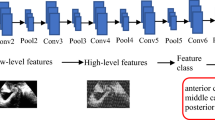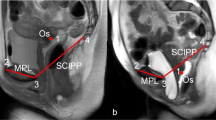Abstract
Introduction and hypothesis
We aimed to develop a deep learning-based multi-label classification model to simultaneously diagnose three types of pelvic organ prolapse using stress magnetic resonance imaging (MRI).
Methods
Our dataset consisted of 213 midsagittal labeled MR images at maximum Valsalva. For each MR image, the two endpoints of the sacrococcygeal inferior-pubic point line were auto-localized. Based on this line, a region of interest was automatically selected as input to a modified deep learning model, ResNet-50, for diagnosis. An unlabeled MRI dataset, a public dataset, and a synthetic dataset were used along with the labeled image dataset to train the model through a novel training strategy. We conducted a fivefold cross-validation and evaluated the classification results using precision, recall, F1 score, and area under the curve (AUC).
Results
The average precision, recall, F1 score, and AUC of our proposed multi-label classification model for the three types of prolapse were 0.84, 0.72, 0.77, and 0.91 respectively, which were improved from 0.64, 0.53, 0.57, and 0.83 from the original ResNet-50. Classification took 0.18 s to diagnose one patient.
Conclusions
The proposed deep learning-based model were demonstrated feasible and fast in simultaneously diagnosing three types of prolapse based on pelvic floor stress MRI, which could facilitate computer-aided prolapse diagnosis and treatment planning.




Similar content being viewed by others
References
Haylen BT, Maher CF, Barber MD, et al. An International Urogynecological Association (IUGA)/International Continence Society (ICS) joint report on the terminology for female pelvic organ prolapse (POP). Int Urogynecol J. 2016;27(4):655–84.
Fialkow MF, Newton KM, Lentz GM, Weiss NS. Lifetime risk of surgical management for pelvic organ prolapse or urinary incontinence. Int Urogynecol J. 2008;19(3):437–40.
Wu JM, Hundley AF, Fulton RG, Myers ER. Forecasting the prevalence of pelvic floor disorders in US women 2010 to 2050. Obstet Gynecol. 2009;114(6):1278–83.
Pannu HK, Kaufman HS, Cundiff GW, Genadry R, Bluemke DA, Fishman EK. Dynamic MR imaging of pelvic organ prolapse: spectrum of abnormalities. Radiographics. 2000;20(6):1567–82.
Yang A, Mostwin JL, Rosenshein NB, Zerhouni EA. Pelvic floor descent in women: dynamic evaluation with fast MR imaging and cinematic display. Radiology. 1991;179(1):25–33.
Comiter CV, Vasavada SP, Barbaric ZL, Gousse AE, Raz S. Grading pelvic prolapse and pelvic floor relaxation using dynamic magnetic resonance imaging. Urology. 1999;54(3):454–7.
Luo J, Chen L, Fenner DE, Ashton-Miller JA, DeLancey JO. A multi-compartment 3-D finite element model of rectocele and its interaction with cystocele. J Biomech. 2015;48(9):1580–6.
Dietz HP. Ultrasound in the assessment of pelvic organ prolapse. Best Pract Res Clin Obstet Gynaecol. 2019;54:12–30.
Dietz HP. Pelvic floor ultrasound: a review. Am J Obstet Gynecol. 2010;202(4):321–34.
Noll LE, Hutch JA. The SCIPP line–an aid in interpreting the voiding lateral cystourethrogram. Obstet Gynecol. 1969;33(5):680–9.
Yuan J, Liao H, Luo R, Luo J. Automatic radiology report generation based on multi-view image fusion and medical concept enrichment. In: Proceedings of International Conference on Medical Image Computing and Computer-Assisted Intervention, 2019. pp 721–729.
Zhang Y, Wang X, Xu Z, Yu Q, Yuille A, Xu D. When radiology report generation meets knowledge graph. In: Proceedings of the AAAI Conference on Artificial Intelligence, 2020;07:12910–12917.
Monshi MMA, Poon J, Chung V. Deep learning in generating radiology reports: a survey. Artif Intell Med. 2020;106:101878.
Robinson CJ, Swift S, Johnson DD, Almeida JS. Prediction of pelvic organ prolapse using an artificial neural network. Am J Obstet Gynecol. 2008;199(2):193.e1–6.
Onal S, Lai-Yuen S, Bao P, Weitzenfeld A, Hogue D, Hart S. Quantitative assessment of new MRI-based measurements to differentiate low and high stages of pelvic organ prolapse using support vector machines. Int Urogynecol J. 2015;26(5):707–13.
Yuan Y, Qin W, Buyyounouski M, et al. Prostate cancer classification with multiparametric MRI transfer learning model. Med Phys. 2019;46(2):756–65.
Baltruschat IM, Nickisch H, Grass M, Knopp T, Saalbach A. Comparison of deep learning approaches for multi-label chest X-ray classification. Sci Rep. 2019;9(1):1–10.
Larson KA, Luo J, Guire KE, Chen L, Ashton-Miller JA, DeLancey JOL. 3D analysis of cystoceles using magnetic resonance imaging assessing midline, paravaginal, and apical defects. Int Urogynecol J. 2012;23(3):285–93.
Tumbarello JA, Hsu Y, Lewicky-Gaupp C, Rohrer S, DeLancey JO. Do repetitive Valsalva maneuvers change maximum prolapse on dynamic MRI? Int Urogynecol J. 2010;21(10):1247–51.
Trowbridge E, Fultz N, Patel D, DeLancey J, Fenner D. Distribution of pelvic organ support measures in a population-based sample of middle-aged, community-dwelling African American and white women in southeastern Michigan. Am J Obstet Gynecol. 2008;198(5):548.e1–6.
Swenson C, Smith T, Luo J, Kolenic G, Ashton-Miller J, DeLancey J. Intraoperative cervix location and apical support stiffness in women with and without pelvic organ prolapse. Am J Obstet Gynecol. 2017;216(2):155.e1–8.
Clark K, Vendt B, Smith K, et al. The Cancer Imaging Archive (TCIA): maintaining and operating a public information repository. J Digit Imaging. 2013;26(6):1045–57.
Karras T, Laine S, Aittala M, Hellsten J, Lehtinen J, Aila T. Analyzing and improving the image quality of StyleGAN. In: Proceedings of the IEEE/CVF Conference on Computer Vision and Pattern Recognition (CVPR), 2020. pp 8110–8119.
Feng F, Ashton-Miller JA, DeLancey JO, Luo J (2021) Feasibility of a deep learning-based method for automated localization of pelvic floor landmarks using stress MR images. Int Urogynecol J32:3069–75.
Betschart C, Chen L, Ashton-Miller J, DeLancey JO. On pelvic reference lines and the MR evaluation of genital prolapse: a proposal for standardization using the Pelvic Inclination Correction System. Int Urogynecol J. 2013;24:1421–8.
He K, Zhang X, Ren S, Sun J. Deep residual learning for image recognition. In: Proceedings of the IEEE Conference on Computer Vision and Pattern Recognition (CVPR), 2016. pp 770–778.
Deng J, Dong W, Socher R, Li L-J, Li K, Fei-Fei L. Imagenet: a large-scale hierarchical image database. In: Proceedings of the IEEE Conference on Computer Vision and Pattern Recognition (CVPR), 2009. pp 248–255.
Kingma DP, Ba J. Adam: a method for stochastic optimization. arXiv preprint arXiv:14126980.
Selvaraju RR, Cogswell M, Das A, Vedantam R, Parikh D, Batra D. Grad-CAM: visual explanations from deep networks via gradient-based localization. Int J Comput Vision. 2020;128(2):336–59.
Chen L, Lisse SA, Larson KA, Berger M, Ashton-Miller J, DeLancey J. Structural failure sites in anterior vaginal wall prolapse: identification of a collinear triad. Obstet Gynecol. 2016;128(85S):862.
Hsu Y, Chen L, Summers A, Ashton-Miller J, DeLancey JO. Anterior vaginal wall length and degree of anterior compartment prolapse seen on dynamic MRI. Int Urogynecol J. 2007;19:137–42.
Swenson C, Simmen AM, Berger M, Morgan D, DeLancey J. The long and short of it: anterior vaginal wall length before and after anterior repair. Int Urogynecol J. 2015;26:1035–9.
Irvin J, Rajpurkar P, Ko M, Yu Y, Ciurea-Ilcus S, Chute C, Marklund H, Haghgoo B, Ball R, Shpanskaya K. Chexpert: a large chest radiograph dataset with uncertainty labels and expert comparison. In: Proceedings of the AAAI Conference on Artificial Intelligence, 2019. pp 590–597.
Acknowledgements
We gratefully acknowledge support from NSFC General Program grant 31870942, Peking University Clinical Medicine Plus X—Young Scholars Project PKU2020LCXQ017 and PKU2021LCXQ028, PKU-Baidu Fund 2020BD039, NIH R01 HD038665, and P50 HD044406.
Author information
Authors and Affiliations
Contributions
X.Y. Wang: protocol/project development, data analysis, manuscript writing/editing; D. He: protocol/project development, data analysis, manuscript writing/editing; F. Feng: data analysis, manuscript editing; J.A. Ashton-Miller: protocol/project development, manuscript editing. J.O.L. DeLancey: protocol/project development, data collection or management, data analysis, manuscript editing; J.J. Luo: protocol/project development, data collection or management, data analysis, manuscript writing/editing
Corresponding author
Ethics declarations
Conflicts of interest
None.
Additional information
Publisher's note
Springer Nature remains neutral with regard to jurisdictional claims in published maps and institutional affiliations.
Rights and permissions
About this article
Cite this article
Wang, X., He, D., Feng, F. et al. Multi-label classification of pelvic organ prolapse using stress magnetic resonance imaging with deep learning. Int Urogynecol J 33, 2869–2877 (2022). https://doi.org/10.1007/s00192-021-05064-7
Received:
Accepted:
Published:
Issue Date:
DOI: https://doi.org/10.1007/s00192-021-05064-7




